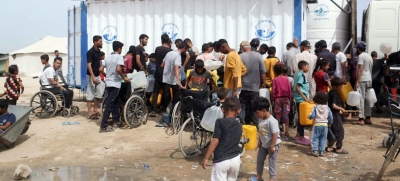In his first public statement about Israel’s war with Hamas, Lebanese Hezbollah leader Hassan Nasrallah on Friday indicated that the Shia militant group — though supportive of Hamas’ bloody October 7 attack on Israel — wouldn’t be opening up another front in the war just yet.
Hezbollah, which the US and other countries have designated as a terror group, has engaged in cross-border firefights with Israel since the October 7 attack. That’s not particularly new; there is regularly low-level conflict across the so-called Blue Line, the line of demarcation between Lebanon and Israel, which UN peacekeepers have been deployed to monitor since 2006. But given its proximity to the conflict and Hezbollah’s close affiliation with Iran, it’s a possible front to expand the war.
Lebanon is not the only place at risk of spillover conflict; Iran-backed militias have been attacking US forces in Iraq and Syria, launching 27 attacks at US bases since October 17 after several months without any such attacks. And the Houthis, an Iran-backed Shia group which controls much of southern Yemen, have lobbed missiles and drones in Israel’s direction, though those have been intercepted by US warships in the eastern Mediterranean, as well as by Israeli missile defense systems. “The Iranians are happy to activate their proxy groups and let other people do the fighting and dying — and frankly a lot of the proxy groups are happy to do the fighting and dying,” Jon Alterman, president of the Middle East Program at the Center for Strategic and International Studies, told Vox.
Iran, to varying degrees, funds and provides resources to each of these groups, as well as Hamas. “Iran’s relationship with other groups really fits onto a spectrum,” Ali Vaez, director of the Iran project at the International Crisis Group, told Vox. “At one side of the spectrum you have Hezbollah, because Iran’s relationship with Hezbollah is really like two NATO allies.” Hezbollah has only Iran as a state backer, while Hamas and militant groups in Iraq and Syria have relationships with other nations.
Though Nasrallah and Iranian leadership have praised Hamas’ attack and threatened retaliation for Israel’s aggressive bombing and ground campaign in Gaza — whether through a proxy group or outright — a “red line” for doing so isn’t clear nearly a month into the war.
All of these groups give Iran options about where and how it wants to send messages to its adversaries — the US and Israel — while ostensibly giving the Islamic Republic a measure of plausible deniability. But this tactic is not without risk, especially without direct diplomatic channels between the adversaries.
“To me, there are two ways this could expand: one is by calculation, and one is by miscalculation,” Alterman said. Iran likely would not want to attack Israel or the US decisively and directly, but an error or a step too far by Iran or any of its proxies could push the conflict outside the bounds of Gaza. “At a time of heightened alert … somebody’s missile could go awry, it may kill somebody. You could have commanders who are freelancing,” or working outside the directions of Iran or another proxy group,”anything can happen, and you can get yourself into a pretty rapid escalation pretty quickly.”
Hezbollah has fought Israel before — and it’s better-equipped now
Though none of the proxy groups would act without Iran’s go-ahead, Hezbollah is in lock-step with Iran ideologically and tactically; Nasrallah and his group are not acting independently. But Lebanon has its own longstanding conflict with Israel, and Hezbollah plays a big role in that.
Israelhas occupied the Shebaa farms area, which was once part of southern Lebanon, since 1967, and invaded southern Lebanon in 1978 and 1982, ultimately occupying part of the country south of the Litani river until 2000. Lebanon was in the midst of a brutal, sectarian civil war, and Hezbollah emerged in the early 1980s in part to serve and represent the Shia population in the south, which was being marginalized by the Lebanese Christian ruling minority as well as an influx of Sunni Muslim Palestinian refugees and resistance groups, upsetting Lebanon’s precarious political balance.
Over time, and with significant Iranian support, Hezbollah emerged as a potent political and militant force in southern Lebanon and on the national stage. Militarily, Hezbollah aimed to push the Israel Defense Forces (IDF) out of southern Lebanon. When Hezbollah in July 2006 fired rockets at Israeli positions and crossed the border to kill and kidnap IDF soldiers, Israel attacked Lebanon, setting off just over a month of war until a UN-mediated ceasefire took effect August 14.
Since that conflict, Hezbollah has grown its capabilities; Nasrallah claims his group has 100,000 fighters, thousands of whom have been honing their skills by supporting Bashar al-Assad’s forces in Syria over the past 12 years. Iran has also maintained its support, helping the group obtain a vast arsenal of rockets and artillery, including longer-range Iranian models with higher payloads. Hezbollah also now possesses the ability to retrofit older rockets and turn them into precision-guided missiles, according to Reuters. That means Hezbollah could fire deeper into Israel and target critical infrastructure.
Hezbollah is also a political actor, holding 62 seats as part of a coalition in Lebanon’s parliament. It lost a number of seats in the last round of elections and a war would be extremely unpopular in Lebanon, which is undergoing both a political and economic crisis; the country has been without a government for a year, and its currency, the lira, is at an all-time low value of 100,000 to the dollar. US officials have met with the Lebanese caretaker government in an effort to try and prevent the conflict from spreading into Lebanon.
Hezbollah maintaining power in Lebanon also means Iran keeping power in the country — power which it aims to deploy when necessary. “Once Iran needs to use Hezbollah, they will, despite what happens to Lebanon,” Hanin Ghaddar, a senior fellow at the Washington Institute for Near East Policy told Vox. And though it has a larger ground force than Hamas “they would be running up against probably 100,000 fully alert, dug-in Israeli troops — and that is a suicidal mission,” James Jeffrey former US special envoy to the Coalition to Defeat ISIS, told Vox. For now, Iran has likely calculated the threat of Hezbollah’s increased missile arsenal is enough to keep Israel from taking significant action in Lebanon.
Hamas officials have met with Hezbollah senior leaders in Lebanon — and likely encouraged them to do more to support Hamas or otherwise challenge Israel, Ghaddar said. But whether they do so will depend entirely on Iran, Ghaddar said. “Hezbollah’s job today is to protect Iranian interests, not to support Hamas or the Palestinians.”
Though Hamas and Hezbollah do coordinate regarding attacks on Israel, Ghaddar said, “Hamas’ expectation was a lot more [support]” against Israel. “I think what happened is [Hamas] realized they are being thrown into the fire for Iran to establish certain political gains,” such as scuttling normalization processes between Israel and Arab states. ‘Hezbollah’s job is to protect these gains and help Iran use the Hezbollah threat to translate these gains into more political, economic gains. And Hamas really has been duped into this [conflict].”
More peripheral groups also present a risk
The US, meanwhile, has launched multiple airstrikes against proxy groups in Iraq and Syria since attacks on US installations resumed on October 17. But rather than real threats of a new front in the war, these and Houthi missiles launched toward Israel look more like a signal of Iran’s displeasure about Israel and the US’ military actions than they do a real threat of escalation — for now.
“There is a core network of Iranian-controlled groups in Iraq that run these front groups” which are carrying out rocket attacks on US bases in Iraq and Syria, according to Phillip Smyth, an independent analyst who focuses on Hezbollah and jihadi groups in the region. Several core jihadi groups affiliated with the Iranian Revolutionary Guard Force, or IRGC, are directing a number of front groups in Iraq and Syria.
These groups have been launching rocket attacks since about 2020, after the assassination of Qasem Suleimani, a revered leader in the Iranian military. Some of the groups have been around much longer — since 2005 at least — and are trusted allies of the Iranian regime. They’re unlikely to deviate from Iran’s strategy and interests in the region. But other, smaller front groups aren’t necessarily quite so closely aligned, Smyth said, and can sometimes mistakenly go off-course or outright flout Iran’s orders.
Hamas official Osama Hamdan did meet with the leader of the front group Asaib Ahl Al Haq, according to the UAE outlet the National. Hamdan told Lebanese pro-Iran TV channel Al Mayadeen that Hamas is ”looking forward to an important role to be played by Iraq for the Palestinian cause.”
But that meeting doesn’t signal that these front groups will do anything more than lob rockets at US military installations — unless Iran decides it serves their interest.
As for the Houthis, many factions of the group are intensely loyal to Iran, but they have their own interests, too — namely regaining control in Yemen. For 1,000 years a Zaydi Shia imamate ruled Yemen, but it was overthrown in 1962 and Yemen’s Zaydi Muslims — of which the Houthis are part — were stripped of their political power. The Houthi movement started in the 1990s, as a protest against increasing Saudi financial and religious power in northern Yemen. Iran and Hezbollah support the Houthis because they see the Houthis as part of a Shia revival and struggle against Sunni Islam.
Yemen has been in a brutal civil war between the Houthis and the Saudi-backed central government, creating the worst humanitarian crisis in the world, according to the UN. Though the Houthis have made gestures of solidarity with Hamas by launching rockets, they’re also unlikely to open up another front in the war simply because they have their own concerns, namely trying to negotiate a political settlement and officially end the conflict. There’s also the issue of serious, unrelenting poverty in Yemen and increased terrorist violence by al Qaeda in the Arabian Peninsula (AQAP).
Iran, for its part, also has significant domestic problems that make it difficult to imagine they’d risk direct conflict with the US and Israel; the government and the Supreme Leader are extremely unpopular, as evidenced by widespread protests over the past year. Surging poverty, unemployment, and inflation are further angering ordinary Iranians; open conflict isn’t likely to help the government’s problems.
Public sentiment in the US, though generally supportive of Israel, would not support further US involvement in the Middle East. And growing protests against the war and calls for an immediate ceasefire given the devastation Israel has brought on Palestinian civilians in Gaza are pushing US officials to de-escalate the conflict.
Israel has thus far ignored those calls —from the US, its neighbors, and from its own citizens. So far in the conflict IDF strikes have killed 9,488 Palestinians according to the Gaza Health Ministry, and 12 Hamas leaders, according to the IDF.






